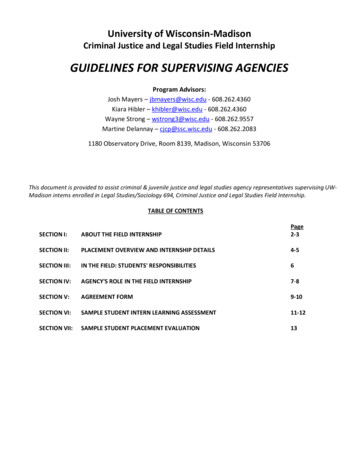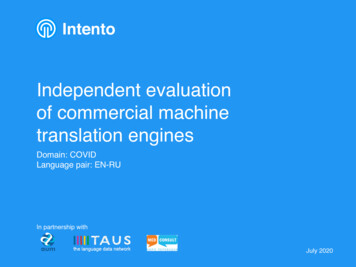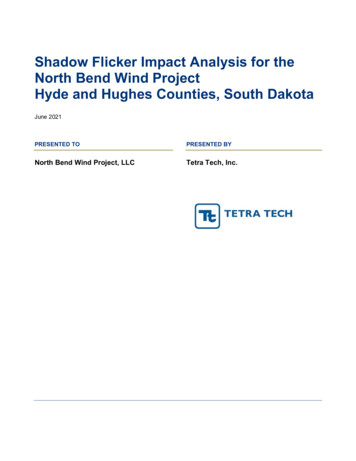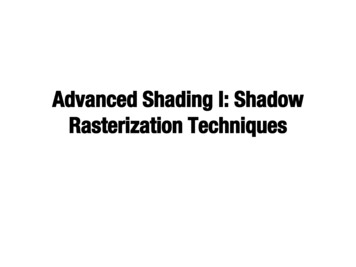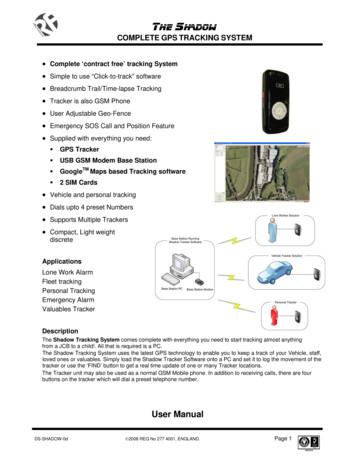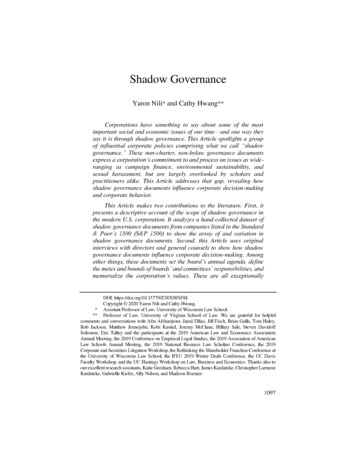
Transcription
Shadow GovernanceYaron Nili* and Cathy Hwang**Corporations have something to say about some of the mostimportant social and economic issues of our time-and one way theysay it is through shadow governance. This Article spotlights a groupof influential corporatepolicies comprising what we call "shadowgovernance." These non-charter, non-bylaw governance documentsexpress a corporation'scommitment to andprocess on issues as wideranging as campaign finance, environmental sustainability, andsexual harassment, but are largely overlooked by scholars andpractitionersalike. This Article addresses that gap, revealing howshadow governance documents influence corporate decision-makingand corporatebehavior.This Article makes two contributions to the literature. First, itpresents a descriptive account of the scope of shadow governance inthe modern U.S. corporation.It analyzes a hand-collected dataset ofshadow governance documents from companies listed in the Standard& Poor's 1500 (S&P 1500) to show the array of and variation inshadow governance documents. Second, this Article uses originalinterviews with directors and general counsels to show how shadowgovernance documents influence corporate decision-making. Amongother things, these documents set the board's annual agenda, definethe metes and bounds of boards'and committees'responsibilities,andmemorialize the corporation'svalues. These are all exceptionallyDOI: https://doi.org/10.15779/Z385D8NF8J.Copyright D 2020 Yaron Nih and Cathy Hwang.*Assistant Professor of Law, University of Wisconsin Law School.Pmfessor of Law, University of Virginia School of Law. We are grateful for helpfulcomments and conversations with Afm Afsharipour, Jared Ellias, Jill Fisch, Brian Galle, Tom Haley,Rob Jackson, Matthew Jennejohn, Kobi Kastiel, Jeremy McClane, Hillary Sale, Steven DavidoffSolomon, Eric Talley and the participants at the 2019 American Law and Economics AssociationAnnual Meeting, the 2019 Conference on Empirical Legal Studies, the 2019 Association of AmericanLaw Schools Annual Meeting, the 2019 National Business Law Scholars Conference, the 2019Corpomte and Securities Litigation Workshop, the Rethinking the Shareholder Franchise Conference atthe University of Wisconsin Law School, the BYU 2019 Winter Deals Conference, the UC DavisFaculty Workshop, and the UC Hastings Workshop on Law, Business and Economics. Thanks also toour excellent research assistants, Katie Gresham, Rebecca Hart, James Kardatzke, ChristopherLarmourKardatzke, Gabrielle Kiefer, Ally Nelson, and Madison Roemer.1097
1098CALIFORNIA LAW REVIEW[Vol. 108:1097important corporate functions that are relegated to shadowgovernance documents, where shareholders and other corporateoutsiders have little ability to effect change.This Article's exploration of shadow governance documents isboth theoretically and practically important. Shadow governancedocuments are not just poorly understood they are also largelyoverlooked by scholars and practitioners. This Article's account hasthe potential to open a new field for scholarly researchand to providenew strategiesfor those who wish to influence corporatebehavior.Introduction.I. Shadow Governance Documents.A. Core Governance Documents: Charter and Bylaws.B. Shadow Governance Documents .1. Committee charters .2. Governance guidelines.3. Codes of conduct.4. Non-required committee charters.5. Non-required additional disclosures.C. Patterns and Commonalities.1. Volume of disclosure.2. Clusters of policy adoption.3. Content similarity.D. Methodology.II. Influence from the Shadows.A. The importance of shadow governance documents .B. "Stickiness".C. Path dependency in policy adoption and revision.D. Disclosure Differentiation.E. Influence of proxy advisors.F. Methodology.III. Implications for Theory and Practice.A. Expanding the Theoretical Scope of Governance.B. Putting Shadow Governance to Work .Conclusion.Appendix A: Full List of Shadow Governance Documents .Appendix B: Volume of Disclosure.Appendix C: Textual Analysis of Audit Committee Charters .Appendix D: Interview 91129113611411141114311441146
2020]SHADOW GOVERNANCE1099INTRODUCTIONThree years after its involvement in the landmark U.S. Supreme Court casethat recognized a for-profit corporation's claim of religious beliefi arts-andcrafts retailer Hobby Lobby made the news again. This time, the United Statessued Hobby Lobby in a federal court in the Eastern District of New York,alleging that Hobby Lobby smuggled thousands of ancient artifacts into theUnited StateS.2 As part of its settlement with the U.S. government, Hobby Lobbyagreed to return the artifacts, pay a fine, and "adopt internal policies to bettergovern its importation of cultural items . . . ."3A quick search of company websites shows that internal policies coveringa breadth of governance functions, from importation policies like HobbyLobby's to CEO succession-planning policies, are common. Moreover,companies' disclosure of these policies is both voluminous and detailed.4 Butwhat is the point of these policies? Do they influence corporate behavior, and, ifso, how? Both the scholarly literature and practitioners' literature is surprisinglythin on information about these non-charter, non-bylaw governance documents.This Article seeks to address this gap and spotlight how these "shadowgovernance documents" set the corporate agenda and steer decision-making. Indoing so, this Article also unveils a new area for corporate research and action.For generations, scholars and practitioners alike have focused on charters andbylaws as the primary tools used to influence corporate behavior.5 This Articleshows that shadow governance, too, is a powerful avenue for influence.A corporation comes into existence with the filing of a charter: thecorporation's birth certificate.6 This document outlines the most basic1. See Burwell v. Hobby Lobby Stores, Inc., 573 U.S. 682, 689-91 (2014) (holding thatcorporate persons had protected rights to freedom of religion under the First Amendment and ReligiousFreedom Restoration Act of 1993, and the U.S. Department of Health and Human Services requirementon corpomtions to provide health insurance coverage for contmception violated the religious beliefs ofHobby Lobby's owners).2. Complaint at 8-9, United States v. Appmximately Four Hundred Fifty (450) AncientCuneiform Tablets, No. 17-3980 (E.D.N.Y. July 5, 2017).3. Alan Feuer, Hobby Lobby Agrees to Forfeit 5,500 Artifacts Smuggled Out of Iraq, N.Y.TIMES (July 5, 2017), lobby-artifacts-smuggleimq.html [https://perna.cc/6ZL8-DMF5] (reporting on Hobby Lobby's asset forfeiture case and itssettlement with the U.S. government, which included the adoption of internal policies).4. Appendix A pmvides a detailed list of the types of shadow governance documents thatcompanies adopt, and the frequency with which companies adopt them. However, even a brief reviewof company websites provides plentiful examples. See, e.g., Export and Import Policies, describing Monsanto's policies reganding export and import); PoliticalEngagement Policy in theUnited States, COCA COLA CO., tices/politicalengagement-in-the-united-states [https://perma.cc/MX36-GGAY] (describing Coca Cola's policyreganding political contributions, lobbying, public policy alignment, and legal compliance andmanagement oversight).5. See infra Part I.A (pmviding an overview of bylaws and charters).6. Sometimes called the articles of incorporation or certificate of incorporation, a charter is thelegal document that establishes the corpomtion within the state of incorporation, thereby choosing the
1100CALIFORNIA LAW REVIEW[Vol. 108:1097information about the corporation, including its name and state of incorporation.After the charter is filed, corporate leadership drafts and adopts the corporation'sbylaws-an internal document that provides more details about how acorporation is run.7 This document might describe how many committees theboard of directors has and may outline general committee responsibilities. sIf these details sound sparse, it is because they are. Together, the charterand bylaws of Facebook, a company worth over half a trillion dollars,9 run amere twenty-four pages.io These twenty-four pages provide very few detailsabout how to run the world's largest social media conglomerate, and they saynext to nothing about how the company makes decisions, what principles guidethose decisions, and what values the company espouses. Instead, those detailscan be found in Facebook's six shadow governance documents, which aredisclosed on the company's website, and concern issues as wide-ranging as theprocess for dealing with conflicts of interest and corporate opportunities and thecompany's policies on sexual harassment, and as granular as retirement ages forboard directors.i 1And Facebook is by no means special-shadow governance ispresent in other companies, perhaps even more extensively. McDonald's, forinstance, discloses twenty shadow governance documents, 12and the averagelarge company discloses more than ten.13laws that will govern the corporation. A charter generally must contain the name of the corporation, theaddress of the corporation's office, the nature of the corporation's business, the corporation's stockauthorization and par value, and the names and addresses of the incorpomtor or incorporators. See DEL.CODE ANN. tit. 8, § 102 (West 2015).7. For a discussion of corporate bylaws, see DEL. CODE ANN. tit. 8, § 109(b) (West 2015) andMODEL Bus. CORP. ACT § 2.06(b) (AM. BAR Ass'N 2016) (both discussing the substance of bylaws, aswell as the pmcess of adopting and amending bylaws).8.See DEL. CODE ANN. tit. 8, § 109(b) (West 2015); MODEL Bus. CORP. ACT § 2.06(b) (AM.BAR Ass'N 2016).9. As of May 22, 2020, the market capitalization of Facebook was 669.28 billion. SeeFacebookMarketCap2009 net/stocks/charts/FB/facebook/market-cap [https://perma.cc/DH7P-Q5D6].10.See Facebook'sRestated Certificate of Incorpomtion (May 22, ration.pdf [https://perna.cc/XHA3-HPS2]; Facebook's Amended and Restated Bylaws (April -downloads/govemance .11.Companies disclose many of their shadow governance documents on investor ault.aspx [https://perma.cc/22WP-T4CA].12. McDonald's Corporation Corporate Governance Principles, MCDONALD'S (May inciples-policies-andguidelines/CORPORATE GOVERNANCEPRINCIPLES 2019.pdf[https://perma.cc/DN4R4TXH] [hereinafter McDonald's Governance Principles 2019].13.See infra Appendix B (noting that companies in the top quartile by market capitalizationdisclose an average of 10.95 documents, while the bottom quartile disclose an average of 8.4documents).
2020]SHADOW GOVERNANCE1101Despite its prevalence, relatively little is known about shadow governance.Instead, most major debates about corporate governance, and the long-standingpush and pull between management, shareholders, and regulators, have beenfought on charter and bylaw grounds. 14Managers, for instance, use charters and bylaws to maintain their powerand insulate themselves from outside influence, as well as to advance thecorporate interest. 15 In the mergers and acquisitions context, managers amendedcharters-introducing staggered boards and the dramatically named poisonpill-to fend off hostile takeovers.16 To help corporations reduce their taxliabilities, lawyers devised a way for corporations to reincorporate into tax-14.Among the recent high-pmfile fights are the issues of dual class shares, passive investorsvoting rights, and pmxy access. For a discussion of the agency costs generated by dual-class structureswith small-minority contmllers, see Lucian A. Bebchuk & Kobi Kastiel, The Perils of Small-MinorityControllers, 107 GEO. L.J. 1453 (2019); Daniel R. Fischel, Organized Exchanges and the Regulation ofDual Class Common Stock, 54 U. CHI. L. REV. 119, 137-38 (1987) (claiming that dual-class stockfacilitates long-term planning); Zohar Goshen & Assaf Hamdani, Corporate Control and IdiosyncraticVision, 125 YALEL.J. 560,565-67 (2016) (arguing that it couldbe value enhancing to provide a talentedfounder with a lock on control, as it enables that founder to freely implement her strategy and utilize herskills to produce superior returns). For a discussion of passive investors, see Lucian A. Bebchuk et al.,The Agency Problems of Institutional Investors, 31 J. ECON. PERSP. 89 (2017); Jill E. Fisch et al., TheNew Titans of Wall Street: A Theoretical Frameworkfor Passive Investors (European Corp. GovernanceInst., Law Working Paper No. 414/2018, 2019) (reviewing the competing views). For a discussion ofthe pmxy access debate, see Am. Fed'n of State Cty. Mun. Emps. v. Am. Int'l Grp., 462 F.3d 121 (2dCir. 2006); Bo Becker et al., Does Shareholder Proxy Access Improve Firm Value? Evidence from theBusiness Roundtable's Challenge, 56 J.L. & ECON. 127 (2013); Stephen T. Giove et al., Proxy AccessProposals, HARV. L. SCH. F. ON CORP. GOVERNANCE & FIN. REG. (Oct. 19, roxy-access-pmposals-2/ [https://perma.cc/PFY2-77DP].15.See generally Lucian A. Bebchuk, The Myth of the Shareholder Franchise, 93 VA. L. REV.675 (2007) [hereinafter Bebchuk, Shareholder Franchise] (discussing the uneven playing field indirector elections and the power of management in controlling it); Lucian A. Bebchuk & Alma Cohen,The Costs of Entrenched Boards, 78 J. FIN. ECON. 409 (2005) [hereinafter Bebchuk & Cohen, TheCosts] (discussing how boards insulate themselves fmm shareholders and the associated costs); LucianArye Bebchuk, The Casefor Increasing Shareholder Power, 118 HARV. L. REV. 833 (2005) (advocatingfor more shareholder access to the election system of directors); Lucian Arye Bebchuk, The Case forShareholder Access: A Response to the Business Roundtable, 55 CASE W. RES. L. REV. 557 (2005)(supporting increased shareholder access to corporate elections); Lucian Arye Bebchuk, The Case forShareholder Access to the Ballot, 59 BuS. LAW. 43 (2003). But see, e.g., LYNN STOUT, THESHAREHOLDER VALUE MYTH: How PUTTING SHAREHOLDERS FIRST HARMS INVESTORS,CORPORATIONS, AND THE PUBLIC (2012) (discussing how shareholder primacy theory is harmful);Stephen M. Bainbridge, Responses, Director Primacy and Shareholder Disempowerment, 119 HARV.L. REV. 1735, 1744-51 (2006); William W. Bratton & Michael L. Wachter, The Case AgainstShareholder Empowerment, 158 U. PA. L. REV. 653, 653-54, 657-59 (2010) (discussing problemscreated by increase in shareholder power and rise of short-term investors).16.See, e.g., Revlon, Inc. v. MacAndrews & Forbes Holdings, 506 A.2d 173 (Del. 1986);Unocal Corp. v. Mesa Petroleum Co., 493 A.2d 946 (Del. 1985); Air Prods. & Chems., Inc. v. Airgas,Inc., 16 A.3d 48 (Del. Ch. 2011); Carmody v. Toll Bros., 723 A.2d 1180 (Del. Ch. 1998); YakovAmihud et al., Settling the Staggered Board Debate, 166 U. PA. L. REV. 1475 (2018) (addressing thedebate over the efficacy of staggered boards and ultimately determining that the effect of staggeredboards is firm dependent); Lucian A. Bebchuk & Robert J. Jackson, Jr., Toward a Constitutional Reviewof the Poison Pill, 114 COLUM. L. REV. 1549 (2014) (questioning the role of state law in authorizingpoison pills).
1102CALIFORNIA LAW REVIEW[Vol. 108:1097advantageous jurisdictions.17 And more recently, to fend off multi-jurisdictionshareholder suits, most large companies have adopted bylaw provisions limitingthe jurisdictions in which shareholders can sue them. 1sCorporate outsiders have focused their efforts on charters and bylaws whentrying to influence change. Major players, including hedge fund activists, 19 proxy17.See Cathy Hwang, The New CorporateMigration: Tax Diversion Through Inversion, 80BROOK. L. REv. 807 (2015) (discussing the pmcess by which corporations reincorporate outside ofUnited States jurisdictions to reduce their corporate tax rates); Eric L. Talley, CorporateInversions andthe Unbundling of Regulatory Competition, 101 VA. L. REv. 1649 (2015) (discussing the effect ofcorporate inversions on the United States' traditional advantage as a global regulatory competitor).18.Several years ago, for instance, Chevron adopted a "forum selection clause" in its bylaws,stating that all shareholder suits would need to be filed in Delaware unless Chevron consented toalternate jurisdiction. At the time, shareholders often filed similar suits in multiple jurisdictions, whichincreased defense costs for corporations. Chevron's amendment caused a storm of controversy amongpractitioners and scholars alike. Shortly after the Delaware Supreme Court found the amendment valid,however, the majority of U.S. public companies adopted forum selection bylaws, thereby dramaticallyreducing the number of shareholder suits filed. See Chevron Corp., Current Report (Form 8-K), at 2(Sept. 29, 2010) [hereinafter Chevron's Form 8-K] ("[U]nless the Corporation consents in writing to theselection of an alternative forum, the Court of Chancery of the State of Delaware will be the sole andexclusive forum for (i) any derivative action or proceeding brought on behalf of the Corporation, (ii) anyaction asserting a claim of breach of a fiduciary duty owed by any director, officer or other employee ofthe Corporation to the Corporation or the Corporation's stockholders, (iii) any action asserting a claimarising pursuant to any provision of the Delaware General Corporation Law, or (iv) any action assertinga claim governed by the internal affairs doctrine. The amendment further pmvides that any person orentity purchasing or otherwise acquiring any interest in shares of capital stock of the Corporation isdeemed to have notice of and consented to the foregoing provision."); see also Matthew D. Cain et al.,The Shifting Tides ofMerger Litigation, 71 VAND. L. REv. 603, 631 (2018) (documenting the dramaticdecrease in number of merger-related lawsuits after the widespread adoption of forum selection bylaws);Joseph A. Grundfest, The History and Evolution of Intra-CorporateForum Selection Clauses: AnEmpirical Analysis, 37 DEL. J. CORP. L. 333 (2012) (documenting the increase in forum selectionclauses); Helen Hershkoff & Marcel Kahan, Forum-Selection Provisionsin Corporate "Contracts,"93WASH. L. REv. 265 (2018) (analyzing the emerging use of forum selection clauses and critiquing theirtreatment under contract law).19.Hedge funds are activist investors who accumulate large but non-contmlling stakes in targetcompanies in order to bring about change in the company's strategic, operational, or financial activity,often while threatening to nominate their representatives to the board. For a detailed definition, see AlonBray et al., Hedge FundActivism, Corporate Governance, and Firm Peformance, 63 J. FIN. 1729,1734-36 (2008); Bebchuk, ShareholderFranchise,supranote 15 (discussing impediments to replacingboards even when shareholder dissatisfaction is high); Lucian A. Bebchuk, Alon Bray & Wei Jiang, TheLong-Term Effects of Hedge Fund Activism, 115 COLUM. L. REv. 1085, 1087 (2015) [hereinafterBebchuk, Hedge FundActivism] (highlighting the recent increase in shareholder activism and creatinga debate as to whether such activism is more beneficial or harmful); Marcel Kahan & Edwand B. Rock,Hedge Funds in CorporateGovernance and CorporateControl, 155 U. PA. L. REv. 1021, 1024 (2007)(noting how hedge funds have become critical players in corporate governance and control).
2020]SHADOW GOVERNANCE1103advisory finS,2o and institutional investors,21 have tried to change corporatestructures almost exclusively through charter modifications that promote whatthey believe to be better governance.22Undeniably, charters and bylaws are important avenues for change. Leftunseen, however, is the role that shadow governance plays in shaping corporatebehavior and influencing corporate change. A few shareholders and proxyadvisors have begun to recognize the reality that key social and governanceissues are decided outside the sphere of charters and bylaws, and to pushcompanies to adopt certain shadow governance documentS23 or shine a light oncertain corners of their shadow governance.24Nonbinding shareholder proposals have been one such instrument forchange. In 2016, for example, a group of nuns bought shares of rifle makersSturm Ruger & Co. and American Outdoor Brands and filed shareholderproposals asking those companies to research the production of safer guns.25Groups have also used shareholder proposals (and the ensuing settlements) to&20.Pmxy advisory firms are paramount in influencing shareholder votes. See Ike BrannonJared Whitley, Corporate Governance Oversight and Proxy Advisory Finns, HARV. L. SCH. F. ce-oversight-and-pmxy-advisoryfirms/ [https://perma.cc/MEP4-YF9F] (discussing the importance of proxy advisors). InstitutionalShareholder Services Inc. (ISS) and Glass Lewis are the two largest and most influential proxy advisoryfirms. For a review of the literature, see Stephen Choi et al., The Power of Proxy Advisors: Myth orReality?, 59 EMORY L.J. 869 (2010) (measuring the influence of proxy advisors on shareholder votes);Asaf Eckstein & Sharon Hannes, A Long/ShortIncentive Scheme for Proxy Advisory Finns, 53 WAKEFOREST L. REv. 787,793-98 (2018) (describing the increasing power of proxy advisors).21.The increasing involvement of activist hedge funds and the emergence of proxy advisoryfirms have also stimulated the activism conducted by the traditional institutions, leading to an overallincrease in the number of shareholders willing to take on an active role in the governance of thecorporation. See Stephen J. Choi & Jill E. Fisch, On Beyond CalPERS: Survey Evidence on theDeveloping Role of Public Pension Funds in Corporate Governance, 61 VAND. L. REv. 315 (2008)(documenting the developing mle of public pension funds); David Gelles & Michael J. de la Merced,New Alliances in Battle for Corporate Control, N.Y.TIMES(Mar.18, lliances-in-battle-for-corporate-contml/? php true& type blogs& -0[https://perma.cc/QA6Y-LGQ7];Matteo Tonello, GlobalTrends in Board-ShareholderEngagement, HARV. L. SCH. F. ON CORP. GOVERNANCE & FIN. REG.(Oct. 25, 2013), obal-trends-in-board-shareholderengagement/ [https://perma.cc/RJ9C-E6NV].22.Harvard Law School's Shareholder Rights Project is one such pmject. Thmugh this lawschool clinic, students and professors worked to influence corporate governance at public companies,by declassifying corporate boards.See Shareholder Rights Project, HARV. L. catalog/index.html?o 64841[https://perma.cc/D52M-6EE9].23.See Giove et. al, supra note 14 (discussing proxy access proposals).24.See, e.g., Sarah C. Haan, ShareholderProposalSettlements and the Private Ordering ofPublic Elections, 126 YALE L.J. 262 (2016) (showing that many corporate disclosures about campaignfinance are made as the result of negotiated private settlements with shareholders).25.Liz Moyer, Activist Nuns See Momentum Buildingfor TheirFightAgainstGun Makers AfterFloridaSchool Shooting, CNBC (Feb. 28, 2018), s.html [https://perma.cclAU38-2A9U].
CALIFORNIA LAW REVIEW1104[Vol. 108:1097motivate greater disclosures about corporate campaign spending.26 In 2013, forinstance, shareholders of oil and gas giant Hess Corporation (Hess) advanced aproposal that would require Hess to provide semiannual reporting on allcorporate funds and assets used for political spending.27 When the proposalfailed, shareholders tried again in 2014-and this time, Hess decided tovoluntarily disclose this information.28Shadow governance matters. Viewing the corporate tug-of-war betweenmanagement and shareholders solely through the lens of charter and bylawprovisions is useful, but is also too simplistic a view of the corporation.Corporate governance covers a much broader ecosystem: it includes manypolicies, practices, and documents beyond charters and bylaws. Moreover,unlike the charters and bylaws-where shareholders hold formal powers in theshaping of the governance arrangementS29-shadow governance documents arecontrolled by management alone, with no formal power afforded toshareholder.3o An understanding of the existence and scope of shadow26.Haan, supranote 24.27.Hess Corp., Proxy Statement, at 83 (Schedule 14A) (March 21, 2013) ("Resolved, that theshareholders of Hess Corporation ("Hess" or "Company") hereby request that the Company pmvide areport, updated semiannually, disclosing the Company's: 1. Policies and procedures for making, withcorporate funds or assets, contributions and expenditures (direct or indirect) to (a) participate orintervene in any political campaign on behalf of (or in opposition to) any candidate for public office,or (b) influence the general public, or any segment thereof, with respect to an election or referendum.2. Monetary and non-monetary contributions and expenditures (direct and indirect) used in the mannerdescribed in section 1 above, including: a. The identity of the recipient as well as the amount paid toeach; and b. The title(s) of the person(s) in the Company responsible for decision-making.").28.See PoliticalDisclosure and Accountability Hess Corporation(2014), TRLIUM ASSETMGMT., ation-2014/ [https://perma.cc/G8UC-9EJE]. Hess shareholders have also submitted repeatedproposals sponsored by As You Sow requesting that Hess conduct a carbon asset report reganding the"company's goals and plans to address global concerns regarding fossil fuels and their contribution toclimate change." Hess Corp., Proxy Statement (Schedule 14A), at 59 (Mar. 27, 2014); 2017 ProxyMemo, Hess Shareholder Resolution Report on Carbon Asset Risk, As You Sow .pdf [https://perma.cc/32TW-XXYC]; 2016 Pmxy Memo, Hess ShareholderResolutionReport emo-2016.pdf [https://perma.cclXF98-LKS8]. Though none of theseresolutions have passed, they received increasing support between 2014 and 2017. m &ays yea &initiative &company hess&keyword [https://perma.cc/75YX-R2C8].29.DEL. CODE ANN. tit. 8, § 242(b)(1) (West 2014) (providing for a shareholder vote on&amendments to the charter); id. § 109(a) (West 2015) (providing that shareholders have the right to"adopt, amend or repeal bylaws").30.See WEIL, GOTSHAL & MANGES LLP PUBLIC CO. ADVISORY GROUP, REQUIREMENTS om/-/medialfiles/pdfs/150154 pcag-boadrquirementschart 2015 v21.pdf[https://perma.cc/9M2J-DRM3] (discussing the requirement for public companies regarding theircorporate governance pmctices); PATRICK SCHULTHEIS & JEANA KIM, WILSON SONSINI 17),
2020]SHADOW GOVERNANCE1105governance documents is therefore a crucial first step toward developing better,more complete theories of governance and of the relationship between managersand shareholders. It also carries important practical considerations forshareholders and management alike.This Article proceeds as follows. Part I provides a rich and texturedoverview-the literature's first-on shadow governance. To do so, this Articleuses hand-collected data from website disclosures made by 1,500 major, publiclytraded American companieS.31 This data shows the breadth and depth of shadowgovernance. Shadow governance documents cover a breathtakingly diverserange of issues, from core governance issues, like succession planning, to quirkyones, like policies governing luxury expenditures. Part II fleshes out thisempirical data with interviews with general counsels and board members. Inparticular, Part II asks whether these voluminous policies actually do anythingand it shows that they do. In fact, directors and general counsels take shadowgovernance documents seriously: these documents set board procedures and theboundaries of acceptable behavior, and are used as cure-alls for corporate goalsranging from shareholder settlements to marketing. At the same time, however,directors and general counsels can be surprisingly ad hoc when adopting andmodi
committee charter is the charter for the risk committee, which is disclosed by 18.8 percent of companies. The executive committee charter is disclosed by 11.1 percent of companies, and the charter for the science, technology, and research committee is disclosed by 8 percent of companies. Numerous committee charters


